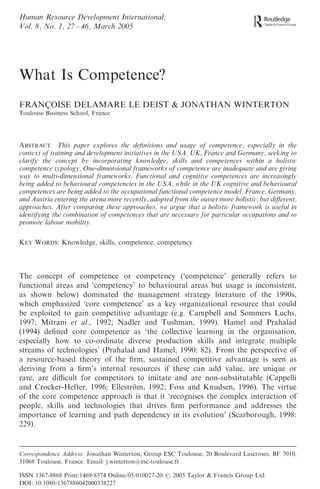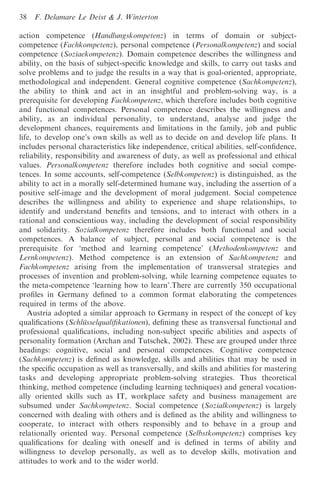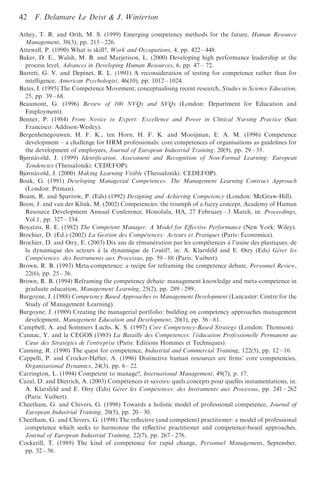This paper explores different definitions and uses of the term "competence" in human resource development contexts. It finds that competence is a "fuzzy concept" with inconsistent usage. The paper analyzes approaches to competence in the US, UK, France, Germany and Austria. It argues that a holistic framework incorporating knowledge, skills, competences and competencies is needed to integrate education/training with labor market needs and promote workforce mobility.


![What Is Competence? 29
incorporating knowledge, skills, competences and competencies within a holistic
competence typology.
Competence as a ‘Fuzzy Concept’
There is such confusion and debate concerning the concept of ‘competence’ that it is
impossible to identify or impute a coherent theory or to arrive at a definition capable
of accommodating and reconciling all the different ways that the term is used. As
Norris argued, ‘as tacit understandings of the word [competence] have been
overtaken by the need to define precisely and [to] operationalize concepts, the
practical has become shrouded in theoretical confusion and the apparently simple
has become profoundly complicated’ (1991: 332). Describing competence as a ‘fuzzy
concept’, Boon and van der Klink nonetheless acknowledge it as a ‘useful term,
bridging the gap between education and job requirements’ (2002: 6).
Snyder and Ebeling (1992) refer to competence in a functional sense, but use
‘competencies’ in the plural. Some authors consistently use ‘competency’ when
referring to occupational competence (Boam and Sparrow, 1992; Mitrani et al.,
1992; Smith, 1993) or treat the two as synonymous (Brown, 1993, 1994). Hartle
argues that competency as ‘a characteristic of an individual that has been shown to
drive superior job performance’ (1995: 107) includes both visible ‘competencies’ of
‘knowledge and skills’ and ‘underlying elements of competencies’, like ‘traits and
motives’. Elkin (1990) associates competences with micro-level job performance and
competencies with higher management attributes and, in defining ‘managerial
competencies for the future’, Cockerill (1989) combines output competences, like
presentation skills, with inputs like self-confidence. The difficulty of using
competence as an overarching term as well as a specific one is demonstrated by
the apparently tautological definition provided by Dooley et al.: ‘Competency-based
behavioural anchors are defined as performance capabilities needed to demonstrate
knowledge, skill and ability (competency) acquisition’ (2004: 317). According to this
construction, competency is a sub-set of itself.
The few attempts to establish coherent terminology (Boak, 1991; Tate, 1995;
Winterton and Winterton, 1999; Woodruffe, 1991) have had little impact to date.
Boak (1991) argues that ‘competency’ in the American sense complements
‘competence’ as used in the UK occupational standards. Burgoyne (1988) similarly
distinguishes ‘being competent’ (meeting the job demands) from ‘having compe-
tencies’ (possessing the necessary attributes to perform competently). Woodruffe
(1991) offers the clearest statement, contrasting areas of competence, defined as
aspects of the job which an individual can perform, with competency, referring to a
person’s behaviour underpinning competent performance. Woodruffe’s definition is
endorsed by Tate who warns against confusing ‘input competencies with output
competences’ (1995: 86).
Mangham (1986) noted that competence may relate to personal models, outcome
models or education and training models, as well as to the standards approach in
which benchmarking criteria are used. Mansfield (2004: 304) similarly contrasts three
different usages of competence: outcomes (vocational standards describing what
people need to be able to do in employment); tasks that people do (describing what
currently happens); and personal traits or characteristics (describing what people are](https://image.slidesharecdn.com/whatiscompetence-13029429961169-phpapp01/85/What-Is-Competence-3-320.jpg)





![What Is Competence? 35
Standards were supplemented by an MCI competency model, defining behavioural
performance indicators. Nevertheless, the MSC definition of competence was
subsequently adopted as the official Employment Department approach in defining
occupational standards as ‘a description of something which a person who works in
a given occupational area should be able to do. . .[and] able to demonstrate’
(Employment Department and NCVQ, 1991). A government review of vocational
qualifications in 1996 (Beaumont, 1996) expanded the definition of competence as:
‘The ability to apply knowledge, understanding and skills in performing to the
standards required in employment. This includes solving problems and meeting
changing demand.’
While the main approach in the UK remains one of functional competence, some
employers developed their own competence frameworks for managers or adopted
other generic models instead of using the MCI Standards (Carrington, 1994; Hirsh
and Strebler, 1994). Some organizations adopted the Hay McBer competency
framework in preference to the competences embodied in the Management
Standards (Mathewman, 1995; Cockerill, 1989). Diverse competence models have
been introduced in relation to competence-based pay systems (Reilly, 2003) and
especially for competence-based management development (Strebler and Bevan,
1996).
Hodkinson and Issitt (1995: 149) argued for a more holistic approach to
competence in the caring professions, integrating knowledge, understanding, values
and skills that ‘reside within the person who is the practitioner.’ Similarly, Cheetham
and Chivers (1996, 1998) claimed to develop a holistic model of professional
competence, comprising five sets of inter-connected competences and competencies.
Their competence framework comprises five dimensions:
. Cognitive competence, including underpinning theory and concepts, as well as
informal tacit knowledge gained experientially. Knowledge (know-that), under-
pinned by understanding (know-why), is distinguished from competence.
. Functional competences (skills or know-how), those things that ‘a person who
works in a given occupational area should be able to do. . .[and] able to
demonstrate’.
. Personal competency (behavioural competencies, ‘know how to behave’), defined
as a ‘relatively enduring characteristic of a person causally related to effective or
superior performance in a job’.
. Ethical competencies, defined as ‘the possession of appropriate personal and
professional values and the ability to make sound judgements based upon these
in work-related situations’.
. Meta-competencies, concerned with the ability to cope with uncertainty, as well
as with learning and reflection.
This framework was applied in an analysis of the future skills needs of managers in
the UK undertaken for the Department for Education and Skills (Winterton et al.,
2000), and in a modified version (where ethical competencies were subsumed under
personal competency, as in the MCI Personal Competency Model) in a study
undertaken for the UK government taxation agency, the Inland Revenue (Winterton
and Winterton, 2002). This later research into the implementation of management](https://image.slidesharecdn.com/whatiscompetence-13029429961169-phpapp01/85/What-Is-Competence-9-320.jpg)










